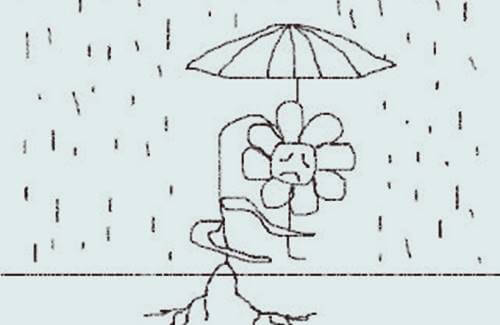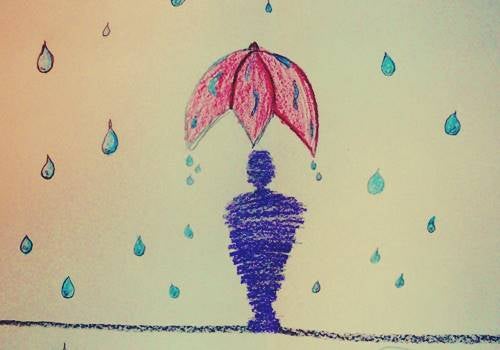What's the Draw a Person in the Rain Test About?


Written and verified by the psychologist Valeria Sabater
The Draw-a-Person-in-the-Rain test is one of the best-known projective instruments, along with others such as the Rorschach test or the tree test. These complementary techniques are useful for gathering more information about a person’s personality. Keep in mind that these aren’t perfect, though.
Projective tests have always been framed within psychoanalytic theory. It’s undoubtedly a somewhat controversial approach from a scientific point of view. In fact, the interpretations are somewhat subjective. However, note that this type of test has been in use for several decades, which is why its systematization continuously improves.
“Don’t be angry with the rain; it simply doesn’t know how to fall upwards.”
-Vladimir Nabokov-
Origin of the Draw-a-Person-in-the-Rain test
In 1924, Psychologist H. M. Fay designed a test called “A Lady-Walking-in-the-Rain” for children between six and 10 years of age. He did so to assess their psychological maturity. The test has changed quite a bit since and is now used with both children and adults.
Nowadays, certain institutions administer it in selection tests and also in the field of child psychology to assess various parts of the personality of a child or teenager personality. Furthermore, you must also note that these tests aren’t standardized and they don’t serve as diagnoses.
The Draw-a-Person-in-the-Rain test requires that a person draw a still or moving figure, someone in the rain in a more or less adverse environment.

Information from the Draw-a-Person-in-the-Rain test
This test is simple: just give a person a piece of paper and a pencil and ask them to draw someone or something in the rain. There are several factors this classic instrument intends to evaluate — beyond the artistic abilities of a person.
It places the person in a situation of moderate stress. The test taker must execute the drawing in a given amount of time and it also requires a certain inventiveness, skill, and precision. However, the quality of the drawing doesn’t really matter but the symbolism instead. That’s what the professional can interpret through it.
A figure in an adverse environment
As mentioned above, the task here is to draw a figure in the rain while understanding this natural phenomenon as a sort of disturbing element. Something like this forces the child or adult to capture on paper someone facing a relatively adverse circumstance. So how do they cope with it?
- As per the name of the test, the first thing a person must do choose the character of their drawing (a man, a woman, or even an animal, a tree, or a flower — the latter is common among children).
- Later, they’ll have to think about how to protect them from the rain (Do they have resources? Do they have an umbrella or appropriate clothing? Is there anything that protects the figure? Are they helpless in the middle of the stormy weather?
- Is the character calm, happy, courageous, or frightened?
All these elements evoke the imprint of a person’s inner world in the selection process. It also traces their state of mind and even their attitude in the face of difficulties.

The application of this test
As mentioned before, it’s a projective instrument that’s easy to apply. To do so, the test giver must follow some specific steps:
- They must engage in a conversation with the test taker and instill confidence and relaxation before handing the sheet. You want the person to feel comfortable so they can elicit their inner world, personality, and state of mind through the drawing.
- After establishing confidence, the professional can offer a blank sheet of paper and give the following instruction: “draw someone in the rain”. They must also indicate that the quality of the drawing won’t be scored because it isn’t that important. Also, there’s no stipulated time, but in general, it should take less than 15 minutes.
- Once they finish, ask them to make another drawing of the same character but without the rain factor this time. This is for comparison purposes.
Evaluation of the Draw-a-Person-in-the-Rain test
As with most projective tests, it’s common to think that these have a subjective interpretation. However, these instruments have been revised over the decades and have specific points to evaluate. It’s also important to take into account the behavior of the person while they draw (if they understand the instruction, hesitate, get nervous, scramble the page, ask for another sheet, etc).
- Analyze size. Some people draw tiny figures under a sky of big clouds. This may reveal anxiety, shyness, insecurity, etc.
- Pay attention to the strokes. Are there many straight lines of strong strokes? It could signal anxiety. Also, many angles, peaks, etc. could reveal aggressiveness.
- Likewise, the professional must analyze the sequence in which a person drew the picture to see if there’s any planning in the drawing. For instance, was the umbrella drawn before the rain? Did they draw the rain without protecting the character first?
- Analyze the movement of the character and the emotional charge given off by the drawing itself along with each element. Some people draw a little man without resources and under the rain and thunder in a corner of the sheet.

Conclusion
This test yields interesting information as long as you use it in conjunction with other diagnostic tests that support the understanding of the intuited diagnosis, in addition to personal interviews. Furthermore, the use of drawings is always a simple and motivating tool for the child to express themselves in the field of child psychology.
Finally, these instruments, along with the Rorschach test, require adequate training to get the most out of them. They’re definitely interesting resources worth taking into account at certain times, no doubt.
All cited sources were thoroughly reviewed by our team to ensure their quality, reliability, currency, and validity. The bibliography of this article was considered reliable and of academic or scientific accuracy.
- Lichtenberg, E. F. (2014). Draw-A-Person-in-the Rain Test. In L. Handler & A. D. Thomas (Eds.), Drawings in assessment and psychotherapy: Research and application (pp. 164-183). New York, NY, US: Routledge/Taylor & Francis Group.
This text is provided for informational purposes only and does not replace consultation with a professional. If in doubt, consult your specialist.








